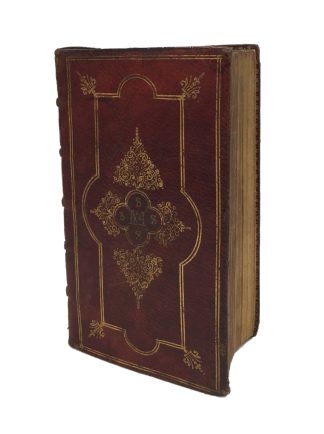AMES, William
BY RUETTE FOR HABERT DE MONTMOR
Bellarminus enervatus, siue Disputationes anti-Bellarminianæ, in illustri Frisiorum Academia, quæ est Franckerae
London [i.e. Amsterdam?], [Printed by W. J. Blaeu?] Ioannem Humpfridum [and H. Robinson], 1633 [i.e. 1632£3,750.00
12mo. Four parts in one . [viii], 208; 218; [ii], 401, [xi]. Roman letter, some Italic and Greek. “In four parts, each with separate dated title pages … Register and pagination differ from the first to the second parts. Register is continuous throughout the remainder of the volume, but part 2 has separate pagination, and parts 3 and 4 are numbered consecutively.” ESTC. Small woodcut ornaments on each title, small floriated initial, “Semin Perpin Soc. jesu catal Inscriptus’ in blank margins of title. Light browning, some minor spotting, occasional small spot or mark. A very good, crisp copy in beautiful contemporary French morocco by Mace Ruette, covers double gilt ruled to a panel design, second with curves at all sides, gilt fleurons to corners of first panel, central arabesque of finely worked scrolled and pointillé tools around inlaid brown morocco centre-piece with the gilt monogram of Habert de Montmor, spine with gilt ruled raised bands, double gilt ruled in compartments, fleuron of gilt pointillé tools at centres, edges gilt ruled with pointillé roll, inner dentelles gilt, combed marbled end-papers, a.e.r., extremities very fractionally rubbed, morocco inlay missing on upper cover.
Beautifully printed edition, in a very fine minuscule Roman, in a stunning contemporary French red morocco binding by Macé Ruette for Habert de Montmor, one of the greatest collectors of Elzévirs of the C17th. Henri Louis Habert de Montmor (c. 1600, Paris – 1679, Paris) was a French scholar and homme de lettres. An avid supporter of Descartes, Habert wrote a poem on Cartesian physics entitled De rerum naturae and collected scientific instruments. He was a friend of Mersenne, who dedicated his Harmonie Universelle to Montmor, and a great friend of Pierre Gassendi, who dedicated to him his Life of Tycho Brahe. Gassendi also left him an astronomical telescope he had been left by Galileo. Three years after Gassendi’s death, Habert edited his complete works in 6 volumes, writing its Latin preface. Besides Gassendi, he gathered a salon of savants and philosophers which included many of the great scholars of the day. He also initiated the bibliophilic tradition of collecting elzévirs, and amassed a remarkable collection of these little masterpieces of Dutch typography. Preserved during his lifetime in his hotel in the Rue Vieille-du-Temple, the collection was dispersed in 1682. From 1620 to 1635, he acquired the volumes as and when they were published, and confided the binding to Macé Ruette, one of the most renowned Parisian masters of his time. Six bindings with the same characteristic decoration are listed in the Catalog II of the Esmerian Library (Nos. 8 to 13). Interestingly this anti-catholic and particularly anti-Jesuit work was later at the Jesuit Seminary in Perpignan.
“William Ames, (born 1576, Ipswich, Suffolk, Eng.—died Nov. 14, 1633, Rotterdam), English Puritan theologian remembered for his writings on ethics and for debating and writing in favour of strict Calvinism in opposition to Arminianism.. .. He served as an observer at the Synod of Dort (1618–19), at which Arminianism was firmly denounced, and as professor of theology at Franeker, in Friesland (1622–33).” Encyclopaedia Britannica. “While at Franeker, Ames produced his major writings, the Medulla Theologiase and De Conscienta, et Etius Iure, vel Casibus. .. Together the two books, his major contribution to seventeenth century theology, show his conviction for pure doctrine and practical divinity. As a polemicist, Ames published in 1625 the first of his Bellarminus Enerevatus, initially begun also as student disputations. It was a thorough blast against the Roman Church and its great Jesuit champion, Saint Robert Bellarmine (1542 -1621). Many protestant writers had given battle to Bellarmine – Franciscus Junius, John Reynolds, William Whitaker, and James I to name a few – and now Ames was taking his turn, going out like David against Goliath of the Philistines, “who afflicts the forces of Israel, the army of the living God.”” Keith L. Sprunger ‘The Learned Doctor William Ames’. “By his first wife Ames had no family; but by his second marriage with the daughter of a gentleman named Sletcher he had a son and a daughter. He appears to have died in necessitous circumstances, for his family received assistance from the town council at Rotterdam, and eventually sailed for New England, taking with them his library, which was hailed as an acquisition of great value by the theological students of the youthful colony.” DNB.
ESTC S116616. STC 551. Devauchelle, II, 141. A. Hobson, French and Italian Collectors, Londres, 1953, n°37. Cat. Esmerian, 1972, A-II. Not in Milward or Alisson and Rogers.In stock




